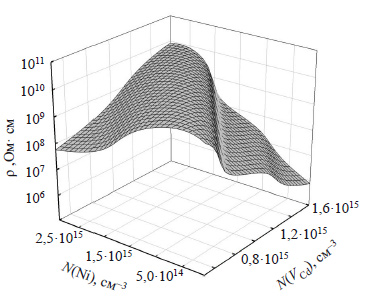Вплив домішок і дефектів структури на властивості детекторів на основі CdTe та CdZnTe
Анотація
Методом комп'ютерного моделювання досліджено вплив легувальних та фонових домішок на прикладі Cl, Fe, Pb, Cr, Co, Ti, V, Ni, Ge, Sn на електрофізичні та детекторні властивості CdTe та Cd0,9Zn0,1Te. З'ясовано вплив вакансій кадмію, донорних домішок, скупчень домішок на деградацію питомого опору та ефективності збору зарядів детекторів іонізуючих випромінювань на основі досліджених матеріалів. Встановлено вплив рівня Фермі та рівнів енергії дефектів на зміну та деградацію властивостей досліджуваних матеріалів.
Посилання
Radiation Detection Systems. Sensor Materials, Systems Technology and Characterization Measurements. 2nd edition. Edited by: Iwanczyk J. S., Iniewski K. CRC Press Taylor & Francis Group, 2021, 323 p.
Caroli E., Moita M., Rui M. Curado da Silva et al. Hard X-ray and soft gamma ray polarimetry with CdTe/CZT spectro-imager. Review. Galaxies, 2018, vol. 6, iss. 3, pp. 69-85. https://doi:10.3390/galaxies6030069
Gazizov I. M., Smirnov A. A. Spectral analysis of the photoconductivity for characterization of CdTe and CdZnTe detectors. J. Phys.: Conf. Ser. 2021, vol. 2127, id. 012041, 12 p. https://doi.org/10.1088/1742-6596/2127/1/012041
Chan Rok Park, Seong-Hyeon Kang, Youngjin Lee. Similarity analysis of pixelated CdTe semiconductor gamma camera image using a quadrant bar phantom for nuclear medicine: Monte Carlo simulation study. Nucl. Eng. and Tech., 2021, vol. 53, iss. 6, pp. 1947-1954. https://doi.org/10.1016/j.net.2020.12.010
Abbaspour S., Mahmoudian B., Islamian J. P. Cadmium telluride semiconductor detector for improved spatial and energy resolution radioisotopic imaging. World J. Nucl. Med., 2017, vol. 16, iss. 2, pp. 101-107. https://doi.org/10.4103/1450-1147.203079
Dubos S., Lemaire H., Schanne S. et al. ORIGAMIX, a CdTe-based spectro-imager development for nuclear applications. Nucl. Instrum. Meth. A, 2015, vol. 787, pp. 302-307. https://doi.org/10.1016/j.nima.2014.12.111
Johns P. M., Nino J. C. Room temperature semiconductor detectors for nuclear security. J. Appl. Phys. 2019, vol. 126, iss. 4, pp. 040902-1- 040902-20. https://doi.org/doi:10.1063/1.5091805
Okamoto T., Igari T., Fukui T. et al. Gamma-ray irradiation effects on CdTe solar cell dosimeter. Jpn. J. Appl. Phys. 2021, vol. 60, pp. SBBF02-1-SBBF02-5. https://doi.org/10.35848/1347-4065/abd6d8
McCoy J. J., Kakkireni S., Gilvey Z. H. et al. Overcoming Mobility Lifetime Product Limitations in Vertical Bridgman Production of Cadmium Zinc Telluride Detectors. J. Electron. Mater. 2019, vol. 48, iss. 7, pp. 4226-4234. https://doi.org/10.1007/s11664-019-07196-5
Nan R., Wang T., Xu G. et al. Compensation processes in high-resistivity CdZnTe crystals doped with In/Al. J. Cryst. Growth, 2016, vol. 451, pp. 150-154. https://doi.org/doi:10.1016/j.jcrysgro.2016.07.032
Kolobov G.A., Karpenko A.V. Refining of light rare, rare earth and radioactive metals. Problems of atomic science and technology, 2016, vol. 101, N 1, pp. 3-9.
Novikov G. F., Radychev N. A. Experimental determination of the dependence of the free electron-hole recombination rate constant on the band gap in semiconductors of the AIIBVI and AIBVII types. Russ. Chem. Bull., 2007, vol. 56, pp. 890-894. https://doi.org/10.1007/s11172-007-0134-9
Shockley W., Read W. T. Statistics of the recombinations of holes and electrons. Phys. Rev., 1952, vol. 87, iss. 5, pp. 835-842. https://doi.org/10.1103/PhysRev.87.835
Fraboni B., Pasquini L., Castaldini A. et al. X-ray irradiation effects on the trapping properties of Cd1-xZnxTe detectors. J. Appl. Phys., 2009, vol. 106, iss. 9, pp. 093713-1 - 093713-6. https://doi.org/10.1063/1.3253748
Nan R., Jie W., Zha G. et al. Irradiation-Induced Defects in Cd0,9Zn0,1Te:Al. J. Electron. Mater. 2012, vol. 41, iss. 11, pp. 2044-2049. https://doi.org/doi:10.1007/s11664-012-2204-5
Xu L., Jie W., Zha G. et al. Radiation damage on CdZnTe:In crystals under high dose 60Co γ-rays. CrystEngComm, 2013, vol. 15, iss. 47, pp. 10304-10310. https://doi.org/10.1039/c3ce41734d
Cavallini A., Fraboni B. Defective states induced in CdTe and CdZnTe detectors by high and low energy neutron irradiation. J. Appl. Phys. 2003, vol. 94, iss. 5, pp. 3135-3142. https://dx.doi.org/10.1063/1.1600529
Nan R., Jie W., Zha G. et al. Determination of trap levels in CZT:In by thermally stimulated current spectroscopy. T. Nonferr. Metal. Soc., 2012, vol. 22, pp. s148 - s152. https://doi.org/10.1016/S1003-6326(12)61700-2
Kondrik A. I., Kovtun G. P. Influence of impurities and structural defects on electrophysical and detector properties of CdTe and CdZnTe. Tekhnologiya i Konstruirovanie v Elektronnoi Apparature. 2019, no. 5-6, pp. 43-50. https://dx.doi.org/10.15222/TKEA2019.5-6.43 [Rus]
Glenn F. Knoll. Radiation Detection and Measurement, 4th edition. John Wiley & Sons, Inc., 2010, 829 p.
Cavallini A., Fraboni B., Auricchio N. et al. Irradiation-induced defects in CdTe and CdZnTe detectors. Nucl. Instrum. Meth. A. 2001, vol. 458, iss. 1-2, pp. 392-399. https://doi.org/10.1016/S0168-9002(00)00931-1
Cavallini A., Fraboni B., Dusi W. et al. Radiation effects on II-VI compound-based detectors, Nucl. Instrum. Meth. A. 2002, vol. 476, iss. 3, pp. 770-778. https://doi.org/10.1016/S0168-9002(01)01674-6
Cavallini A., Fraboni B., Dusi W. et. al. Deep levels and compensation in γ-irradiated CdZnTe. Appl. Phys. Lett. 2000, vol. 77, iss. 20, p. 3212-3216. https://doi.org/10.1063/1.1324980
Hofmann D. M., Stadler W., Christmann P., Meyer B. K. Defects in CdTe and Cd1-xZnxTe. Nucl., Instrum. Meth. A, 1996, vol. 380, iss. 1-2, pp. 117-120. https://dx.doi.org/10.1016/S0168-9002(96)00287-2
Kavanagh S. R., Walsh A., Scanlon D. O. Rapid Recombination by Cadmium Vacancies in CdTe. ACS Energy Lett., 2021, vol. 6, pp. 1392-1398. https://pubs.acs.org/doi/pdf/10.1021/acsenergylett.1c00380
Kondrik A. I., Kovtun G. P. Influence of radiation defects on the electrophysical and detector properties of CdTe:Cl irradiated by neutrons. Tekhnologiya i Konstruirovanie v Elektronnoi Apparature. 2020, no. 1-2, pp. 22-29. https://dx.doi.org/10.15222/TKEA2020.1-2.22 [Rus]
Neumark G. F. Achievement of well conducting wide band-gap semiconductors: Role of solubility and of nonequilibrium impurity incorporation. Phys. Rev. Lett. 1989, vol. 62, iss. 15, pp. 1800-1803. https://doi.org/10.1103/PhysRevLett.62.1800

Авторське право (c) 2022 Кондрик О. І., Ковтун Г. П.

Ця робота ліцензується відповідно до Creative Commons Attribution 4.0 International License.
